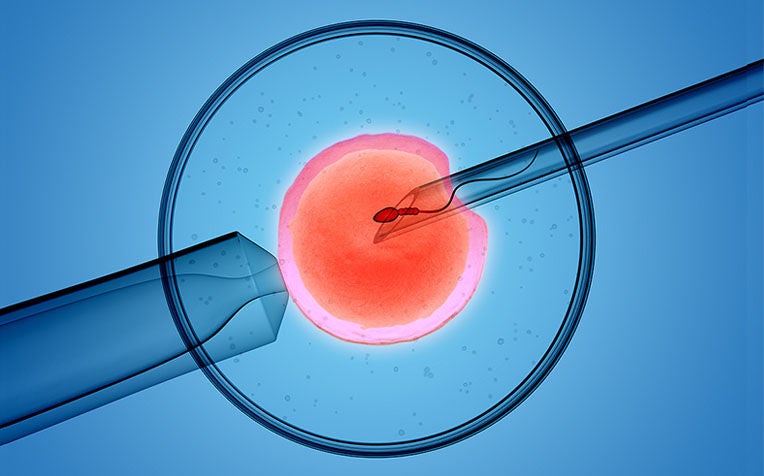
ICSI (Intra-Cytoplasmic Sperm Injection) is usually recommended if the male has poor quality sperm or if the woman has had difficulties with fertilisation in the past.
About 15 per cent of couples (approximately 1 in 8 couples) in Singapore are unable to conceive within 12 months of trying for a baby.
Infertility is the inability to get pregnant after one year of trying to have a child. In 50 per cent of these couples, it is due to the man who may have a medical disorder. However, infertility can be attributed to either man or woman, or both (the table below shows the incidence of the causes of infertility).
Incidence of the causes of infertility | |
|---|---|
Female problem only |
39% |
Male problem only |
20% |
Both male and female probles |
26% |
No obvious cause for infertility |
15% |
Therefore, medical investigation for infertility should involve both the man and woman from the beginning.
Want to improve your chances of conceiving? KKH has tips to share! Watch the video below.
While female infertility is growing worldwide, the good news is that there are plenty of treatment options available for this problem. In fact, over the years, treatment for infertility has become more effective with fewer side effects. It has become more affordable too.
“Treatment has evolved to become more user-friendly with fewer side effects,” shares the KKIVF Centre from KK Women’s and Children’s Hospital (KKH), a member of the SingHealth group.
“In Singapore, more support from the government with the option of co-funding means the treatment is more affordable too," the centre added.
How to know if you should seek help for fertility health? Watch this video to learn more.
IVF (in-vitro fertilisation): When is it necessary?
IVF (in-vitro fertilisation) is the most commonly used assisted reproduction technology (ART). As part of IVF, sperm can be injected into the egg to fertilise it. This is called
ICSI, or intracytoplasmic sperm injection.
IVF may be an option if either you or your partner has been diagnosed with any of the following conditions which may contribute to infertility:
Tubal factor – e.g. tubal damage from previous infections / previous ligation / salpingectomy
Ovulatory problems and/or anovulation – e.g. in Polycystic Ovary Syndrome (PCOS)
Early menopause (premature ovarian failure)
Male infertility – e.g. low sperm count / absent sperm (azoospermia) / inability of sperm to penetrate or survive in the cervical mucous
Unexplained infertility
How does IVF (in-vitro fertilisation) work?
During the process of IVF, fertilization of the eggs with sperm occur in a laboratory — “ in vitro”.
Before fertilisation, hormonal injections are administered for about 2 to 4 weeks to stimulate the follicles within the ovaries.
Eggs are then collected and inseminated (IVF) or injected (ICSI) with the husband’s sperm in the laboratory.
In the IVF procedure, multiple eggs and sperm are brought together in a laboratory glass dish so that the sperms can fertilise the eggs. After fertilisation, the best embryos are placed in the uterus, raising the odds of a successful pregnancy (known as an embryo transfer).
A successful pregnancy can be confirmed 17 days later via a blood test. There are other procedures involved in IVF which are suitable for specific problems.
Your doctor will advise you if any of the following are necessary for you:
Intra-Cytoplasmic Sperm Injection (ICSI)
Intra-Cytoplasmic Sperm Injection (ICSI) involves injecting a single sperm into each egg to allow fertilisation to occur in the laboratory. This is recommended if the man has poor quality sperm or if the woman has had difficulties with fertilisation previously. ICSI may be combined with regular IVF if the woman is having her first ICSI cycle.Blastocyst Culture
Embryos are cultured for 5 days to become a blastocyst. The chances of pregnancy are much higher with a blastocyst transfer. This may be helpful for couples with repeated IVF failure, multiple eggs and if Pre-implantation Genetic. Diagnosis is required.
Who is suitable for IVF (in-vitro fertilisation)?
IVF is the only fertility treatment for women with irreparably damaged or blocked fallopian tubes.
IVF is also offered when infertile women cannot conceive with simpler methods of treatment for conditions such as endometriosis, ovulatory dysfunction, unexplained infertility, sperm disorders and immunological problems.
Is there a best treatment option for female infertility?
Different patients require different treatments depending on their specific problem.
But generally, IVF and ICSI are considered the most effective of all the options. However, for a young woman with no issue, ovulation induction or SOIUI (Supra Ovulation Intrauterine Insemination) may be the best choice.
In some cases, for instance young couples who haven’t been trying for long, simple advice on the frequency of sexual intercourse could suffice.
When infertility is due to a low sperm count, the man has to be treated first. If the semen can be optimised, the woman has a chance of natural conception. If no sperm is produced in the semen, the sperm may be retrieved surgically, which allows the woman to attempt IVF/ ICSI.
A fertile woman who has cancer and is concerned about becoming infertile can preserve her fertility if she desires. “Prevention is better than cure. When a woman requires chemotherapy or radiotherapy, freezing part of the ovary to use it later can help. If the woman is married, freezing the embryo may yield better results,” advises the centre.
Ref: H24 (ed)
Related articles:
Fertility Treatment for Couples (ART): What You Need To Know













 Get it on Google Play
Get it on Google Play